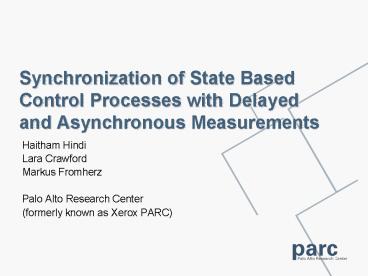Synchronization of State Based Control Processes with Delayed and Asynchronous Measurements - PowerPoint PPT Presentation
1 / 18
Title:
Synchronization of State Based Control Processes with Delayed and Asynchronous Measurements
Description:
Keeps sheet (red) following interpolated way point curve (blue), in ... tracking), feedback (for noise rejection) and lead (look ahead) 3 degrees of freedom ... – PowerPoint PPT presentation
Number of Views:21
Avg rating:3.0/5.0
Title: Synchronization of State Based Control Processes with Delayed and Asynchronous Measurements
1
Synchronization of State Based Control Processes
with Delayed and Asynchronous Measurements
- Haitham Hindi
- Lara Crawford
- Markus Fromherz
- Palo Alto Research Center
- (formerly known as Xerox PARC)
2
Outline
- Context Motivation
- Distributed, networked, cooperative control
- Modular reconfigurable printing
- Overview of technical challenges remedies
- Network delays
- Distributed sensing and actuation
- Focus on controller state synchronization
techniques - Embedded systems issues implementation
- Goal share some hard-learned lessons simple
powerful tricks from the trenches
3
High-End Printing system
- A complex multi-function device
- variety of operations
- complex interactions
- real-time, high-speed operations
- Control software ensures performance and
correctness
4
Modularity, Reconfigurability, Distributed Control
Control
Ca. 1990 monolithic system, central control
5
Hierarchical Networked Paper Path Control Problem
- Distributed system
- Sheet moved by multiple nips
- Sheet sensed by multiple sensors
- Asynchronous measurements
- Due to different length modules noise
- Network delays
- Nips (rollers) sensors communicate across
network via sheet controller - Synchronization
- clock
- controller state
6
3DOF Nip Controller
- Nip controller computes nip motor control command
u - Keeps sheet (red) following interpolated way
point curve (blue), in presence of process
sensor noise - Uses feedforward (for ref. tracking), feedback
(for noise rejection) and lead (look ahead) ? 3
degrees of freedom
7
Handling Asynchronous Detection
- Sheet is detected when edge crosses sensors
- Irregular sensor crossing times cause
asynchronous detection - Handled via standard time-varying Kalman filter
8
Network Delays
9
Handling Random DelaysTime Stamping Delay
Equalization
Network
Delay Equalizer
SensorMgr
MC
Physical System
10
Asynchronous Controller Performance
- Good tracking of way point trajectory
- Arrival window error approx. 4mm ?
15msec_at_0.3m/sec - Peak control (nip speed and acceleration) within
specs - Asynchronous detection cause approx factor of two
error over synchronous
11
Distributed Coordination Network Delays
- Multiple nips joining leaving network
communication delays - ? need careful synchronization technique
- Solution nip-to-nip handoff implemented by
embedding continuous LQG controller in discrete
finite state machine (FSM) - FSM has 4 functions off, synch., compute, and
drive
12
Notation
- Think of controller on each nip as separate
process - Processes p0,,pn-1 run the controller
recursion - xi(t1) f(xi(t),yi(t-d),t) xi(0)
xi0 - ui(t) g(xi(t),yi(t-d),t)
- xi state
- ui control output
- yi measurement input yi,
- d known fixed integer delay
- Same f g for all nips and all sheets
pi
13
Synchronized Processes
- Suppose processes p0,,pn-1 driven by same
measurements and same initial condition, ie - xi0 x0 8 i
- yi(t) y(t) 8 i,t,
- then the processes all run the same recursion
- x(t1) f(x(t),y(t-d),t) x(0) x0
- u(t) g(x(t),y(t-d),t).
- Definition such a set of processes, where the
x(t) and u(t) are identical for all time, as
synchronized.
14
Problem Statement
- Given (1) f, g, and d
- (2) p0,,pn-1 running
synchronized - (3) t d, starting time for
new process pn - (4) d-sample delay in any
message pi ! pj - Goal synchronize new process pn, to p0,,pn-1,
- for all time t t'
- for any state recursion functions f
and g - Specifically, is there some start-up messaging
protocol which will do the job?
15
Solution
- Note performing d iterations of the state
recursion - x(t'-d1) f(x(t'-d),y(t'-2d),t'-d)
- x(t'-d2) f(x(t'-d1),y(t'-2d1),t'-d
1) - x(t') f(x(t'-1),y(t'-d-1),t'-1)
. - ) only need y(t'-2d),,y(t'-d-1) and x(t-d) to
compute x(t) - Requires sending nothing more recent than d time
samples ago! - Protocol to synchronize with p0,,pn-1 8 t
t, pn must - from time (t-d) start receiving measurements y
- at time t have x(t-d) and instantly forward
propagate to x(t') - From t onwards, to remain synchronized, pn
only needs to receive the - same measurements y as p0,,pn-1.
- Used in many distributed applications computer
games, data bases
16
(No Transcript)
17
Results Nip Coordination via FSM
- Results
- As sheet passed on from nip to nip, all nips
touching sheet (blue) produce the same control
signal (red) - As soon as nip finishes moving sheet, nip free to
process other sheets - Status
- Implemented code in embedded processors
- Demonstrated on real prototype hardware
18
Conclusion
- Covered some useful techniques for distributed
coordinated networked control - Time stamping delay equalization
- Time varying Kalman filter estimation
- Controller state synchronization (Hand-off)
- Clock synchronization (phase locked loop not
covered in this talk) - Showed how controller state synchronization can
be accomplished by embedding dynamic controller
in Finite State Machine (FSM) which handles
synchronization - Extremely simple when formulated and implemented
precisely and correctly - These 4 simple yet powerful techniques provide a
good basic tool set for tackling distributed
networked control applications - Golden Rules from The Trenches
- Always try the easiest thing first!
- Have faith in your equations!
- Always pick feasibility over optimality































